![]()
![]()
![]()
Use LEFT and RIGHT arrow keys to navigate between flashcards;
Use UP and DOWN arrow keys to flip the card;
H to show hint;
A reads text to speech;
39 Cards in this Set
- Front
- Back
|
Sedimentary Rocks: An Introduction
|
1. Abundance
2. Description 3. Origin |
|
|
Sedimentary Rocks
|
1. Most abundant rock type at earth’s surface by Area
A. Below sea level – nearly all ocean bottom has thin layer |
|
|
Above Sea Level – 75% of surface
|
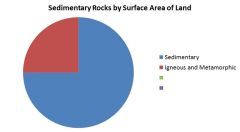
|
|
|
By Volume Sedimentary Rock is Insignificant
|

2. Thin layer overlying igneous and metamorphic rocks
A. 0.8–2 kilometers out of 7-70 km thick crust 3. Thinnest A. Shields on continents B. Cratons on continents C. Abyssal ocean basin 4. Thickest A. Continental shelves on continents and ocean margin B. Post Precambrian fold belts on continents |
|
|
Young rock > Old rock
|

Sedimentary rocks have been recycled many times
|
|
|
Other Sedimentary Rocks
|
1. Chert
2. Phosphorites 3. Evaporites 4. Organic Rich A. Coal B. Lignite C. Oil Shale 5. Iron Rich A. Banded Iron B. Redbeds 6. Tephra and Pyroclastics 7. Cataclasic Breccias |
|
|
Sedimentary Rock Description
|
1. Color
2. Composition 3. Texture 4. Clasts or crystals 5. Fossil content 6. Sedimentary Structures |
|
|
Color
|
1. Lithology of grains
2. Lithology of cement 3. Weathered versus Fresh color |
|
|
Composition
|
1. Chemistry
A. Fragments - Rock fragments - Mineral grains C. Cement D. Diagenetic changes 2. MINERALOGY A. Hand specimen B. Thin section |
|
|
Texture
|
Size, Shape, and Arrangement of grains or crystals
|
|
|
Grains or Clasts
|
1. Detrital Sedimentary Rock
A. Particles transported in the solid state |
|
|
Crystals
|
1. Chemical or Biochemical Sedimentary Rock
A. Transported in dissolved state B. Organic matter |
|
|
Grain Size
|
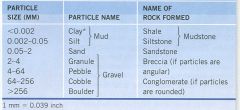
1. Gravel >2mm
2. Sand 2 to 0.0625 or 0.05 mm A. Very coarse B. Coarse C. Medium D. Fine E. Very Fine 3. Silt 0.625 or 0.5 to 0.004 or 0.002 mm A. Coarse B. Medium C. Fine 4. Clay <0.004 or 0.002 mm |
|
|
Grain Shape
|

|
|
|
Grain Sphericity
|
1. Minerals
A. Controlled by cleavage 2. Rock Fragments B. Controlled by bedding |
|
|
Grain Roundness
|
1. Controlled by transportation
2. Controlled by hardness 3. Controlled by cleavage |
|
|
Good Sphericity, Poor Roundness, Poor Sorting
|

|
|
|
Good Rounding, Poor Sphericity, Mediocre Sorting
|
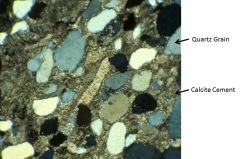
|
|
|
Fossils
|
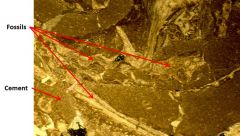
|
|
|
Grain Sorting
|

|
|
|
Controlled by Transportation
|
1. Increasing Viscosity = decreasing sorting
2. Increasing Distance = increasing sorting 3. Increased # Cycles = increasing sorting |
|
|
Fossil Content
|
1. Presence or absence
2. Whole or broken 3. Dominant fossil types 4. Trace fossils |
|
|
Sedimentary Structures
|
1. Large scale
2. Three dimensional 3. Depositional 4. Post-depositional |
|
|
Depositional Sedimentary Structures - Bedding
|

|
|
|
Depositional Sedimentary Structures Cross Bedding
|
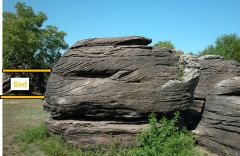
|
|
|
Depositional Sedimentary Structures - Ripples
|

|
|
|
Sedimentary Rock Geometry
|
1. Very large three-dimensional shapes
2. Thickness 3. Internal features |
|
|
Sedimentary Rock: Origin
|
1. Provenance
2. Weathering 3. Transporting Agent 4. Depositional Setting 5. Stratigraphy and Paleogeography 6. Diagenesis |
|
|
Provenance
|

1. Source area location
2. Source area mineralogy/chemistry |
|
|
Weathering
|
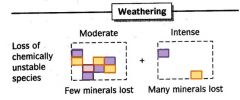
1. Changing mineralogy/chemistry
A. Unstable minerals chemically depleted B. Stable minerals concentrated C. New minerals formed |
|
|
Transportation
|
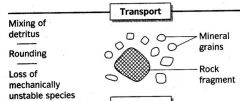
1. Mixing clasts and solutes
2. Sorting clasts and solutes 3. Rounding clasts 4. Depleting mechanically unstable clasts |
|
|
Deposition
|
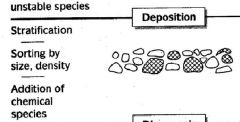
1. Sorting clasts by size and density
2. Sorting solutes by chemical environment 3. Sedimentary structures |
|
|
Stratigraphy
|
1. Sequence of rocks
2. Extent of rocks 3. Equivalence of rocks in time - correlation 4. Equivalence of rocks in space - correlation |
|
|
Diagenesis
|

1. Cementation
2. Authigenic mineral formation 3. Compaction and grain deformation 4. Dissolution 5. Recrystallization |
|
|
Quartz-cemented quartz sandstone
|

|
|
|
Compaction
|
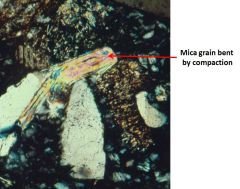
|
|
|
Cementation
|

|
|
|
Dissolved grain
|
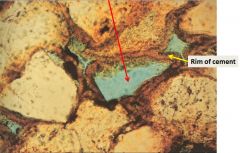
|
|
|
Dissolution and Authigenic Grains
|
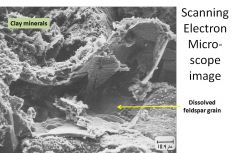
|

